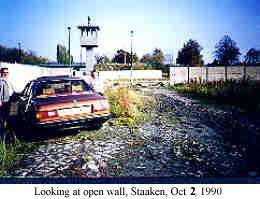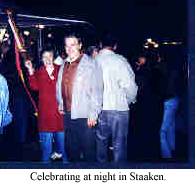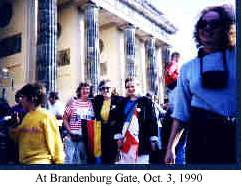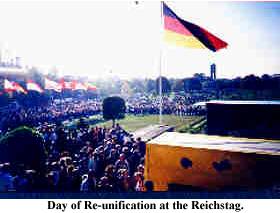 | The story of the reunification of Germany. by Ursula Grosser Dixon |
 | The story of the reunification of Germany. by Ursula Grosser Dixon |

 Ursula's
History Web
Ursula's
History WebDuring the summer of 1990 I was watching Scola, on the satellite, a broadcast for learning and international understanding, originating from Omaha, Nebraska. Different nations took turns, each lasting 30 minutes, to broadcast their news. When West Germany came on, all I could see on the screen was a date in large numbers: 3.10.1990. Then the announcer explained that after an all-night meeting with the government in East Berlin an agreement had been reached. The two countries, East and West Germany would re-unite on this day. Germany would be whole again.
During the months following the collapse of the Berlin wall, Chancellor Kohl in Bonn had apparently worked tirelessly towards unification. It was in my opinion the right thing to do, trying not to lose momentum. If Germany was ever to be re-united, now was the time. The people of East Germany were at loose ends. There were many meetings with the Western Allies as well as with the Russian government. It was obvious from news reports that every one’s approval was needed. Documents were signed at much publicised meetings, they all reached the agreement for Germany to be re-united. The only thing left was to hammer out an accord with the government of East Germany. In this all-night session in East Berlin they agreed on the date of October 3, 1990.
 Having been there when my
homeland had been torn asunder, I wanted to be there when the country
once again became one.
When I heard the date, I immediately booked my flight home with British
Airways for October 1, 1990.
On the flight from London to Berlin the pilot congratulated all German
passengers on the coming event.
Many businessmen from England, the United States and other countries
flew to Berlin just to be there on this historical day. I know this,
because I heard them talking in the plane from London. I arrived in
Berlin-Tegel on the morning of October 2. My cousin Karl Grosser and
his wife were at the airport to meet me. When we got to Berlin-Staaken,
my cousin’s home, as tired as I was from the over night
flight
from Canada, I went to see the remnants of the now defunct wall, which
had divided West Berlin from East Germany, as Staaken was the most
western suburb of West Berlin. Ten months had passed since the wall
fell, but I had only seen it on television from far away. Now I was
walking on the former death strip, looking
at abandoned guard towers, saying over and over again "I
can’t believe it."
Having been there when my
homeland had been torn asunder, I wanted to be there when the country
once again became one.
When I heard the date, I immediately booked my flight home with British
Airways for October 1, 1990.
On the flight from London to Berlin the pilot congratulated all German
passengers on the coming event.
Many businessmen from England, the United States and other countries
flew to Berlin just to be there on this historical day. I know this,
because I heard them talking in the plane from London. I arrived in
Berlin-Tegel on the morning of October 2. My cousin Karl Grosser and
his wife were at the airport to meet me. When we got to Berlin-Staaken,
my cousin’s home, as tired as I was from the over night
flight
from Canada, I went to see the remnants of the now defunct wall, which
had divided West Berlin from East Germany, as Staaken was the most
western suburb of West Berlin. Ten months had passed since the wall
fell, but I had only seen it on television from far away. Now I was
walking on the former death strip, looking
at abandoned guard towers, saying over and over again "I
can’t believe it."
 Around
supper time I went to bed, but three hours later my cousin's wife
Renate shook me awake "Get up, it’s time to celebrate." Still
sleepy I got up and we got ready to go and join in the celebrations.
When we went
outside and around the corner, I could hardly believe what I saw. In a
few short hours merchants had set up stands along both sides of the
street called Torweg. They sold sausages, hamburgers, beer, beer and
more beer. I saw signs reading: Peace cocktails ala Gorbi and ala Bush.
By 10 PM thousands of people
were in the streets, singing, laughing, crying, waving German and
Berliner flags, and strangers from East and Wesr were hugging each
other.
Around
supper time I went to bed, but three hours later my cousin's wife
Renate shook me awake "Get up, it’s time to celebrate." Still
sleepy I got up and we got ready to go and join in the celebrations.
When we went
outside and around the corner, I could hardly believe what I saw. In a
few short hours merchants had set up stands along both sides of the
street called Torweg. They sold sausages, hamburgers, beer, beer and
more beer. I saw signs reading: Peace cocktails ala Gorbi and ala Bush.
By 10 PM thousands of people
were in the streets, singing, laughing, crying, waving German and
Berliner flags, and strangers from East and Wesr were hugging each
other.
 My cousin had planned to take
us all to the Reichstag in the center of the city, where the official
ceremonies
would take place at midnight. The police in Staaken told us it would be
impossible to get near the Reichstag, so we decided to stay in Staaken,
celebrating with the people there in the streets. Shortly before
midnight we all went back to my cousin’s house to watch the
ceremonies with Chancelor Kohl and many other dignitaries on
television. At the stroke of midnight the freedom bell at the Rathaus
Schoeneberg began
to ring, and church bells throughout the land followed suit. (It was at
this city hall in Berlin-Schoeneberg, the seat of the Lord Mayor of the
city of West Berlin, where on June 26, 1963 President Kennedy had told
the largest crowd of people ever assembled on their own in all of
Berlin’s colorful history "Ich bin ein Berliner."
My cousin had planned to take
us all to the Reichstag in the center of the city, where the official
ceremonies
would take place at midnight. The police in Staaken told us it would be
impossible to get near the Reichstag, so we decided to stay in Staaken,
celebrating with the people there in the streets. Shortly before
midnight we all went back to my cousin’s house to watch the
ceremonies with Chancelor Kohl and many other dignitaries on
television. At the stroke of midnight the freedom bell at the Rathaus
Schoeneberg began
to ring, and church bells throughout the land followed suit. (It was at
this city hall in Berlin-Schoeneberg, the seat of the Lord Mayor of the
city of West Berlin, where on June 26, 1963 President Kennedy had told
the largest crowd of people ever assembled on their own in all of
Berlin’s colorful history "Ich bin ein Berliner."
When the police orchestra played the German anthem "Unity and Right and Freedom for the German Fatherland", I completely lost my composure, having promised myself not to do so. It was very quiet in the living room and when I looked around I saw tears in the eyes of every one, young and old. The mood was somber, I could sense everyone’s emotions reflecting the dreadful past and the uncertain future.
Some one said "Let’s go outside and watch the fire works." We could not see too much of it, as the Reichstag was too far away from us. By now people were singing the anthem in the streets, a lot of them waving their flag. As tired as I was, I have never enjoyed a celebration more in my life time. I talked to dozens of strangers, and I even lifted my paper cup filled with champagne and made a toast over the microphone of the disco band, which had been playing all throughout the evening on the former border strip. The festivities lasted until early morning.
THE DAY OF RE-UNIFICATION. Although the day had started at midnight, I would
like to set the day apart from the festivities of the previous night.
The third day of October became on this day a national holiday. From
Spandau, where we left the car at the city hall parking lot, we took
the subway towards the center of the city. The stop nearest the
Reichstag and the Brandenburg Gate is called "Unter den Linden."
When we got up to the street, thousands of people were moving slowly
towards the Brandenburg Gate. On reaching the Gate, I saw that it was
newly decorated with artistic stone work, displaying different eras
in German history. Suddenly I was blinded by tears, until then I had
not realized that we had been crossing through the Brandenburg Gate
from EAST to west. A few minutes later we saw the Reichstag. There in
front of the old imposing building flattered the largest
flag in black, red and gold I had ever seen. All the flags from the
different parts of Germany, from the Bundeslaender, old and new, were
weaving in the mild October breeze.
Camera crews from around the globe were there, with their cameras
mounted high up on tall cranes.
Although the day had started at midnight, I would
like to set the day apart from the festivities of the previous night.
The third day of October became on this day a national holiday. From
Spandau, where we left the car at the city hall parking lot, we took
the subway towards the center of the city. The stop nearest the
Reichstag and the Brandenburg Gate is called "Unter den Linden."
When we got up to the street, thousands of people were moving slowly
towards the Brandenburg Gate. On reaching the Gate, I saw that it was
newly decorated with artistic stone work, displaying different eras
in German history. Suddenly I was blinded by tears, until then I had
not realized that we had been crossing through the Brandenburg Gate
from EAST to west. A few minutes later we saw the Reichstag. There in
front of the old imposing building flattered the largest
flag in black, red and gold I had ever seen. All the flags from the
different parts of Germany, from the Bundeslaender, old and new, were
weaving in the mild October breeze.
Camera crews from around the globe were there, with their cameras
mounted high up on tall cranes.
 We spent the afternoon in the vicinity of the
Reichstag, then slowly we made our way to the city transit, taking the
train back to Spandau. Back in Staaken we watched a Philharmonic
concert on television that night. We enjoyed a beautiful medley of
classical music by well-known composers of the past.
It was the end of an incredible day.
We spent the afternoon in the vicinity of the
Reichstag, then slowly we made our way to the city transit, taking the
train back to Spandau. Back in Staaken we watched a Philharmonic
concert on television that night. We enjoyed a beautiful medley of
classical music by well-known composers of the past.
It was the end of an incredible day.
Germany was re-united, Berlin once again its capital. I love the land I have chosen, but the love for one’s homeland surpasses all new affiliations one makes during one’s life time. At least, that's the way it is for me. On my way back to Canada a month later, I remember thinking how very glad I was that I had come home for this historical occasion, and how thankful I was that I had lived to see this day.
There would be many problems in the years to come. A nation divided for decades under completely opposing political systems will have to learn to live and work together all over again. This will take time, but I have no doubts at all that in the years to come they will find their way, not only in a united Germany, but in a peaceful, united Europe.
 for more.
Click HERE
to send Ursula e-mail.
for more.
Click HERE
to send Ursula e-mail.